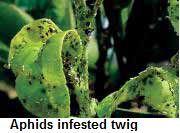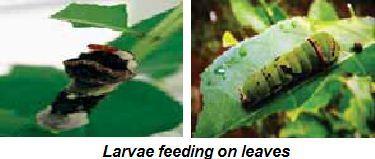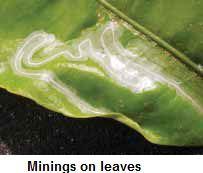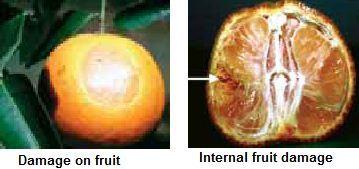Citrus: Insect and Nematode Pests Management
Citrus: Insect and Nematode Pests Management
Citrus aphid
BiologyEgg: Eggs are not produced by this species. Females give birth to living young.
Nymph: There are four nymphal stages of this aphid. The first stage is approximately 1/36 inch in length and the last about 1/17 inch. They are without wings and brownish in color. Newly born nymphs are found grouped together since mothers do not move about while birthing.
Adult:  Only females are found. They are oval, shiny black, brownish-black or reddish brown in color, either with or without wings, measuring 1/25 to 1/12 inch in body length and having short black-and-white banded antennae. Winged individuals tend to have darker abdomens and be slightly thinner. The incidence of winged individuals is dependent on the population density and leaf age. This is the only aphid with an audible stridulation or high piercing sound caused by the aphid rubbing two parts of it body together much like crickets. Large colonies will produce this scrapping sound when they are disturbed. About thirty generations succeed each other and overlap throughout the year.
Only females are found. They are oval, shiny black, brownish-black or reddish brown in color, either with or without wings, measuring 1/25 to 1/12 inch in body length and having short black-and-white banded antennae. Winged individuals tend to have darker abdomens and be slightly thinner. The incidence of winged individuals is dependent on the population density and leaf age. This is the only aphid with an audible stridulation or high piercing sound caused by the aphid rubbing two parts of it body together much like crickets. Large colonies will produce this scrapping sound when they are disturbed. About thirty generations succeed each other and overlap throughout the year.
Favourable conditions:
- The development of this aphid is temperature dependent. The optimum temperature for this aphid is 20 to 25°C.
- Lower winter temperatures and particularly summer heat (above 30°C) slow down development.
- It feeds on tender foliage and flowers.
- It transmits Citrus Tristeza Virus disease.
- Nymphs and adults suck the sap of leaves which leads to wilting and flower dropping.
- Infested leaves become cup shaped and crinkled.
- Growth of the plants is hindered.
Citrus/Lemon-butterfly
 Biology
Biology
Egg: Yellowish white, round, smooth eggs are laid singly on tender leaves and shoots by P. demoleus. Egg hatches in about 3 – 8 days.
Larva: Freshly hatched caterpillars are dark brown and soon develop irregular white markings on their body resembling bird’s drop. The caterpillars feed voraciously on tender leaves right up to the mid ribs and defoliate the entire seedlings or the tree leaving behind only the midribs.
Pupa: The caterpillars attach themselves to branches with silk, transforming into pupae. They remain in the pupal form for 2–3 weeks before emerging as adults.
Adult: P. demoleus is a big beautiful butterfly with yellow and black markings on all the four wings, having wing expanse of about 50-60 mm. Its hind wings have a brick red oval patch near the anal margin and there is no tail like extension behind though common in Papilionidae. P. polytesmales are black and females vary in form. P. helenushas black wings with three white distal spots.
Favourable conditions:
- The larval population density will be high during October to December months and July to December is the most favourable period of its activity in general.
- Citrus butterfly was able to survive during the winter even though temperatures dropped below 0°C.
- Caterpillars prefers on light green tender leaves
- Feeding voraciously and leaving only the mid-ribs
- Severe infestation the entire tree gets defoliated.
Citrus psylla
Biology
Egg: Eggs are 0.2-0.3 mm pear shaped organe to yellow initially turn darker as they are ready to hatch.
Nymph: Its nymphs are yellow, orange or brown with flattened bodies. They are hard to see, since they’re only 1/100 to 1/14 inch long. The nymphs also secrete a sticky substance called honeydew that attracts sooty mold.
Adult: The Asian citrus psylla is a tiny, mottled-brown, winged insect that damages curry leaf plants when it sucks sap out of young leaves. This psyllid grows to be between 1/16 and 1/8 inch long with red eyes and short antennae.
Favourable conditions:
- Summer and rainy seasons.

- Asian citrus psyllids are mottled brown insects that feed directly on the leaf of the curry tree.
- This causes damage to the leaves and stems, and can also introduce bacteria to the tree.
- Psyllids, like other Homoptera, have piercing sucking mouthparts used for feeding on plants.
- Feeding by psyllid adults and nymphs causes newly forming leaves to twist and curl similar to feeding damage from the green aphid.
- Psyllid feeding also results in reduction of shoot length giving a witches’ broom effect
- If heavy feeding occurs early on the developing flush, the new flush will fail to develop or abort.
- In addition to direct feeding damage, honeydew inside the white waxy secretions produced by the nymphs promotes the growth of sooty mold which can reduce effective leaf area for photosynthesis
Citrus leaf miner
Biology
Egg: Eggs are very tiny (about 1.0 mm long and 0.2 mm wide), greyish or yellowish white and slightly translucent. They are laid inside the leaf tissue, just below the leaf surface. In some instances eggs are laid below the epidermis of fruits/pods (e.g. peas). Eggs hatch in about 3 days.
Larva: They are small yellow maggots (about 2 to 3 mm long when fully-grown). They are found feeding inside the leaf tissue, leaving long, slender, winding, white tunnels (mines) through the leaf. They pass through 3 larval stages. After 5 to 7 days the maggots leave the mines and pupate either on the leaf surface or - more commonly - in the soil. In some cases, maggots pupate within the mines.
Pupa: Pupae are very small, about 2 mm long and 0.5 mm wide) oval, slightly flattened ventrally with variable colour varying from pale yellow-orange to golden-brown. They have a pair of cone-like appendages at the posterior end of the body. Adults emerge 4 to 5 days after pupation.
Adult: Adult flies are small, about 2 mm long. They are greyish to black with yellow markings. Female flies are slightly larger than males. The life cycle varies with host and temperature. The average life cycle is approximately 21 days in warm conditions, but can be as short as 15 days. Thus, populations can increase rapidly.
Favourable conditions:
- Citrus leaf miner develops best at temperatures between 70º to 85ºF and greater than 60% relative humidity, but will readily adapt to most California conditions.
 Citrus leaf miner larvae feed by creating shallow tunnels, referred to as mines, in young leaves.
Citrus leaf miner larvae feed by creating shallow tunnels, referred to as mines, in young leaves.- It is most commonly found on citrus (oranges, mandarins, lemons, limes, grapefruit and other varieties) and closely related plants (kumquat and calamondin).
- The larvae mine the lower or upper surface of the leaves causing them to curl and look distorted.
- Mature citrus trees (more than 4 years old) generally tolerate leaf damage without any effect on tree growth or fruit yield.
- Citrus leaf miner is likely to cause damage in nurseries and new plantings because the growth of young trees is retarded by leaf miner infestations.
However, even when infestations of citrus leaf miner are heavy on young trees, trees are unlikely to die.
Mealy bug
Biology
Egg: Eggs are deposited as white cottony masses called ovisacs on trunk and stems of citrus plants, giving the appearance of cotton spread on plants. The glossy, light yellow eggs are oval and approximately 0.3 mm long. A female can lay from 300 to 600 eggs in her life period, which are deposited in groups of 5 to 20. Depending on the season, egg hatch may occur after 6 - 10 days or several weeks. An average of 29 eggs per day is laid by females.
Nymphs: Nymphs emerge from the ovisacs and typically settle along midribs and veins on the underside of leaves, young twigs, and fruit buttons. Wax and honeydew secreted by crawlers are visible indicators of infestations. First instar female and male nymphs are called crawlers. The nymphs take 6 to 10 weeks to reach maturity. The nymphs are yellow, oval-shaped with red eyes, and covered with white waxy particles The female nymphs resemble the adult female in appearance, while male nymphs are more elongated. Female nymphs have four instars. Males differ greatly; they have three instars and a pre-pupal stage.
Adult:  Adult size ranges in length from 3 mm (females) to 4.5 mm (males). The females are wingless, white to light brown in color, with brown legs and antennae. The body of adult females is coated with white wax and bears a characteristic faint gray stripe along their dorsal side. Short waxy fi laments can be seen around the margins of their oval body with a slightly longer pair of fi laments present at the rear end of their body. Female mealy bugs are wingless and, therefore, must be transported to subsequent host plants, although they are able to crawl for short distances. The immature can be blown by wind. Females can live for up to 29 days depending on the host plant. Males are similar in color to females and have two long backward-projecting white wax threads.
Adult size ranges in length from 3 mm (females) to 4.5 mm (males). The females are wingless, white to light brown in color, with brown legs and antennae. The body of adult females is coated with white wax and bears a characteristic faint gray stripe along their dorsal side. Short waxy fi laments can be seen around the margins of their oval body with a slightly longer pair of fi laments present at the rear end of their body. Female mealy bugs are wingless and, therefore, must be transported to subsequent host plants, although they are able to crawl for short distances. The immature can be blown by wind. Females can live for up to 29 days depending on the host plant. Males are similar in color to females and have two long backward-projecting white wax threads.
Damage symptoms:
- Citrus mealy bug is a sporadic pest of citrus, occurring primarily in older, well-shaded groves planted on heavy soils.
- They will feed on the roots, bark, foliage, and fruit. The citrus mealy bug injects toxic saliva while extracting plant sap resulting in defoliation, fruit discoloration, fruit splitting, and fruit drop.
- Mealy bugs usually gather in large numbers, causing premature leaf drop and twig dieback when they feed. Like psyllids, they secrete honeydew, which attracts black sooty mold.
Fruit sucking moth
Biology
Egg: Eggs may be laid singly, or in egg masses containing 50-750 eggs. Placement may be on the underside of young leaves, or on any part of the host. Sometimes eggs may be placed on unsuitable hosts, particularly when the population density is high.
Larva: There are four molts and five instars. Total development time for larvae is about 21 days. Larvae can be found feeding anytime on the underside or edges of leaves, but typically feed between 5 PM and 10 AM. When in danger, young larvae tend to respond by dropping to the ground, while older larvae may exhibit a characteristic aggressive posture and swaying motion.
Pupa: Pupation occurs in an average of 12.5-17.8 days within a pupal cocoon that may remain in the tree or drop to the ground after drying.
Adult:  The adult moth is large and robust. The eyes are large. The area behind the head of the moth, the thorax, is pale to purple-brown and the abdomen is pale brown at the base brightening to yellow-orange at the tip. The forewings resemble a leaf by being olive to purple-brown and may have white and green colored flecks (the colored flecks are more common on females). This leaf-like appearance of the forewings makes this moth difficult to see when it is at rest, especially, because the bright hind wings are not visible. The outer edges of the female’s forewings are scalloped or toothed where those of the male’s are evenly curved. The hind wings are bright orange, have a black comma-shaped mark and are fringed by a black border with white dots.
The adult moth is large and robust. The eyes are large. The area behind the head of the moth, the thorax, is pale to purple-brown and the abdomen is pale brown at the base brightening to yellow-orange at the tip. The forewings resemble a leaf by being olive to purple-brown and may have white and green colored flecks (the colored flecks are more common on females). This leaf-like appearance of the forewings makes this moth difficult to see when it is at rest, especially, because the bright hind wings are not visible. The outer edges of the female’s forewings are scalloped or toothed where those of the male’s are evenly curved. The hind wings are bright orange, have a black comma-shaped mark and are fringed by a black border with white dots.
Damage symptoms:
- It is a serious pest of maturing mandarin fruits.
- The adults puncture the ripening fruits.
- Such fruits drop prematurely as a result of rotting due to fungal and bacterial infections introduced through punctures causing considerable fruit loss.
Citrus blackfly
Biology
Egg: Eggs are laid in a spiral pattern on the underside of the leaf. Each female lays two to three egg-spirals during her 10 to 14 day life span. Eggs hatch within seven to 10 days.
Nymph: The first instar is elongate-oval, averaging 0.30 mm long x 0.15 mm wide and is brown in colour, with two glassy fi laments curving over the body. The first instar lasts seven to 16 days. The second instar is more ovate and convex than the first instar, averaging 0.40 mm long x 0.20 mm wide, and is dark brown in colour with numerous spines covering the body. The second instar lasts seven to 30 days. The third instar is more convex and much longer than the second, averaging 0.87 mm long x 0.74 mm wide. The body is shiny black with spines stouter and more numerous than those in the second instar. The third instar lasts six to 20 days.
Pupa: The fourth instar, or so-called pupa case, is ovate and shiny black with a marginal fringe of white wax. The sex is readily distinguishable. Females average 1.24 mm long x 0.71 mm wide; males are 0.99 mm long x 0.61 mm wide. The pupal stage lasts 16 to 50 days.
Adult: The adult emerges from a T-shaped split appearing in the anterior end of the pupal case. At emergence, the head is pale yellow, legs are whitish, and eyes are reddish-brown. Within 24 hours after emergence, the insect is covered with a fi ne wax powder which gives it a slate blue appearance.
Favourable conditions:
- The development with high density citrus blackfly populations, especially during cool temperature and high humidity seasons.
 Citrus black fly is an endemic pest. The pest attack the crop during all the three flushing periods viz., Ambia (Jan.-Feb.), Mrig (Jun.- July) and Hasta (Oct.- Nov.) bahar and completes three generations in a year.
Citrus black fly is an endemic pest. The pest attack the crop during all the three flushing periods viz., Ambia (Jan.-Feb.), Mrig (Jun.- July) and Hasta (Oct.- Nov.) bahar and completes three generations in a year.- Both nymphs and adults suck cell sap and secrete voluminous honeydew on which sooty mould grows wildly that leads to fungal manifestation (Capnodium sp.) locally called as ‘Kolshi’, covering entire plant due to which photosynthesis is affected.
- Plants are devitalized due to excessive desapping and in severe cases fruit bearing capacity of the tree is also affected. Fruits are rendered insipid in
- taste and blackened due to black sooty mould. Such fruits fetch low price in the market.
Nematode
Damage symptoms Symptoms are more prominent in established orchards as trees are stressed, either by suboptimal growing conditions, drought, or root stunting and decay induced by T. semipenetrans infection. Typically, reduced leaf and fruit size, canopy thinning, and exposure of bare crown limbs are the most conspicuous symptoms of slow decline and result in yield suppression- Slow-decline, die-back, rootlets shortened, soil adhere to gelatinous matrix of egg mass
- Galls on roots, reduction in yield
- Heavily infested roots are darker in colour with branched rootlets
- Swollen and irregular in appearance than in normal ones

IPM for Citrus
To know the IPM practices for Citrus, click here.
Source: NIPHM and Directorate of Plant Protection, Quarantine & Storage
Last Modified : 2/13/2020
This topic covers the information related to Pest ...
This topic covers information about Horsegram Pest...
Provides information about principles to design In...
This topic covers information about Horsegram Ins...
